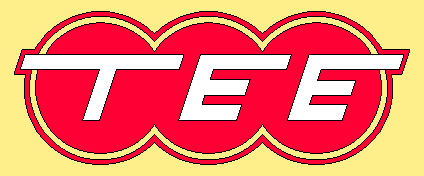
Note: the pictures given here mostly come from the
European Railway Server
although some come from other sites. The thumbnails given here
come from this site.
Clicking on a picture will give you a larger and better quality
from the other site. Many more rail photo's can be found at those
sites.
Diesel Trainsets
SNCF Trainsets
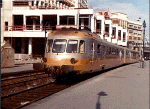 These were based on the already proven RGP 825 trainsets (which is shown by
the photo). They consisted
of a motorcar (X 2771-2781) and a driving trailer (XRS 7771-7779).
The motorcar seated 39 passengers, the trailer had 42 seats,
a kitchen and a service compartment. Built 1956/57. Intermediate
cars have been built, but I do not have information about them. These
sets could be coupled with the original RPG 825 sets, and this was done
on some French parts of TEE routes.
These were based on the already proven RGP 825 trainsets (which is shown by
the photo). They consisted
of a motorcar (X 2771-2781) and a driving trailer (XRS 7771-7779).
The motorcar seated 39 passengers, the trailer had 42 seats,
a kitchen and a service compartment. Built 1956/57. Intermediate
cars have been built, but I do not have information about them. These
sets could be coupled with the original RPG 825 sets, and this was done
on some French parts of TEE routes.
Photo: Patrick Meunier, size: 133257 bytes.
SBB-CFF-FFS/NS Trainsets
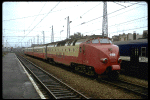 The principle was based on the trainsets already running in the Netherlands.
A set consisted of a motorcar (with compartments for bagage, service and
customs), a compartment car for 54 passengers, a restaurant car seating
32 passengers with compartments for 18 passengers and a driving trailer
seating 42 passengers. Built 1956/57. Numbers:
NS 1001-1003 and SBB-CFF-FFS RAm 501-502.
The principle was based on the trainsets already running in the Netherlands.
A set consisted of a motorcar (with compartments for bagage, service and
customs), a compartment car for 54 passengers, a restaurant car seating
32 passengers with compartments for 18 passengers and a driving trailer
seating 42 passengers. Built 1956/57. Numbers:
NS 1001-1003 and SBB-CFF-FFS RAm 501-502.
Photo: Jean-Paul Lescat, size: 66214 bytes.
DB Trainsets (VT 08)
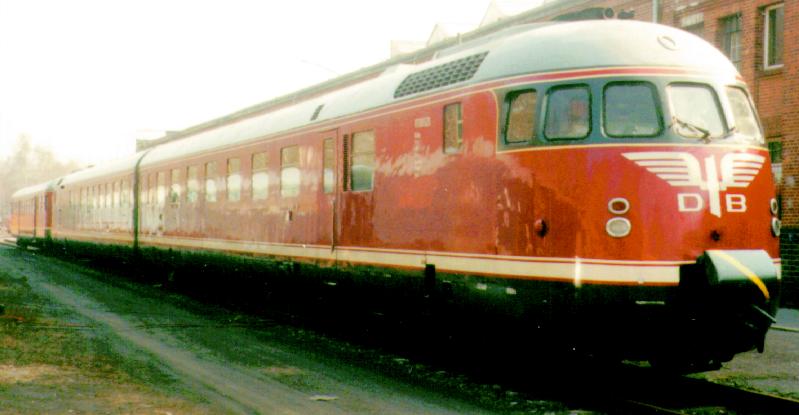 Because the intended trainsets were not ready in time as a temporary measure
some sets of this series have done service in TEE trains.
Because the intended trainsets were not ready in time as a temporary measure
some sets of this series have done service in TEE trains.
Photo: Tobias Köhler, size: 42356 bytes.
The following cars were available (although not all were used in TEE service):
- Motorcars with restaurant part (DR4ü)
- numbered VT 08 501-514.
- Motorcars (A4ü)
- seating 36, numbered VT 08 515-520.
- Compartment carriage (A4ü)
- seating 60, numbered VM 08 501-522.
- Driving trailer (A4ük)
- seating 54, numbered VS 08 501-513.
The trains were built 1952/54. A train consisted of one motor/restaurant
car, one or two compartment cars and a driving trailer or a second motor car
without restaurant part.
DB Trainsets (VT 11)
 Built 1957. Since 1968 numbered in the 601 series. The trainsets were
expandable and could easily be split and joined.
Built 1957. Since 1968 numbered in the 601 series. The trainsets were
expandable and could easily be split and joined.
Photo: Werner Oestreich, size: 56805 bytes.
The following cars were available:
- Motorcars (D4ü)
- numbered VT 11 5001-5019, later 601 001-019.
- Compartment cars (A4ü)
- seating 36 passengers, numbered VM 11 5101-5123, later 901 101-123.
Of these only 15 were built in 1957, 5 followed in 1959, 2 in 1962 and
another one in 1963.
- Open cars (A4y)
- seating 33 passengers, numbered VM 11 5201-5208, later 901 201-208.
- Restaurant car without kitchen (AR4y)
- seating 23 in a restaurant compartment, 7 at a bar and open part with 17
places, numbered VM 11 5301-5308, later 901 301-308.
- Restaurant car with kitchen (R4y)
- also seating 23, numbered VM 11 5401-5409, later 901 401-409.
Normally a trainset consisted of D4ü+A4ü+A4y+AR4y+R4y+A4ü+D4ü, later up to
3 A4ü were added.
FS Trainsets
 Built also 1957 (and two in 1958), but due to late delivery the intended
trains could not start immediately with the beginning of the summer timetable
of 1957. The sets consisted of a motorcar (ALn 442.201-209) seating 42 and
a driving trailer (ALn 448.201-209) seating 48 with a kitchen and customs
compartment. In 1969 ALn 442.202 was replaced by ALn 442.209 and
in 1971 ALn 448.207 by ALn 448.209; both after accidents. Intermediate cars
have been built but were never actually used in the TEE sets.
Built also 1957 (and two in 1958), but due to late delivery the intended
trains could not start immediately with the beginning of the summer timetable
of 1957. The sets consisted of a motorcar (ALn 442.201-209) seating 42 and
a driving trailer (ALn 448.201-209) seating 48 with a kitchen and customs
compartment. In 1969 ALn 442.202 was replaced by ALn 442.209 and
in 1971 ALn 448.207 by ALn 448.209; both after accidents. Intermediate cars
have been built but were never actually used in the TEE sets.
Photo: Paolo Zanin - IRA Italian RAilfans, size: 71069 bytes.
Electric Trainsets
SBB-CFF-FFS Trainsets
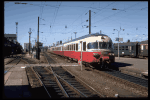 Built in 1961 as RAe II 1051-1054, in 1962 1055 was added. The sets were able
to drive on four different current systems: 1500 and 3000 V DC, 15000 V
16 2/3 Hz AC and 25000 V 50 Hz AC. The motorcar had four pantographs, one
for Switzerland, one for Germany and Austria (originally in this position
there was one for the DC part of France), one for Italy and the AC part
of France and one for the DC part (France, Belgium and the Netherlands,
originally not for France). (Although Switzerland used the same system as
Germany and Austria, requirements for pantographs are very different, hence
the two pantographs for these parts). The driver had in front of him a
push button panel with a button for each region; a single push would
activate the appropriate pantograph and set for the correct current.
The sets consisted of a
driving trailer seating 42, the motor car, a restaurant car with 48 places
plus 6 places at the bar, an intermediate open car with 42 places and
another driving trailer with 42 seats. Later a sixth open car with 42 places
was added at the position where the driving trailer joined the motorcar.
Built in 1961 as RAe II 1051-1054, in 1962 1055 was added. The sets were able
to drive on four different current systems: 1500 and 3000 V DC, 15000 V
16 2/3 Hz AC and 25000 V 50 Hz AC. The motorcar had four pantographs, one
for Switzerland, one for Germany and Austria (originally in this position
there was one for the DC part of France), one for Italy and the AC part
of France and one for the DC part (France, Belgium and the Netherlands,
originally not for France). (Although Switzerland used the same system as
Germany and Austria, requirements for pantographs are very different, hence
the two pantographs for these parts). The driver had in front of him a
push button panel with a button for each region; a single push would
activate the appropriate pantograph and set for the correct current.
The sets consisted of a
driving trailer seating 42, the motor car, a restaurant car with 48 places
plus 6 places at the bar, an intermediate open car with 42 places and
another driving trailer with 42 seats. Later a sixth open car with 42 places
was added at the position where the driving trailer joined the motorcar.
Photo: Jean-Paul Lescat, size: 73172 bytes.
FS Trainsets
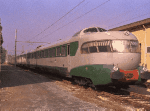 These were not especially built for the TEE but actually very old.
This series (ETR 301-303, the first two built 1953 and the third in 1959)
was already used in the luxuary
Settebello and came into TEE service
without change when the service was classified TEE. When the sets would
be retracted from TEE service in 1984 the train was renamed to
Colosseum
because the old name was connected with the trainsets rather than the service.
Actually these sets consist of three parts; both ends are formed from two cars
with a jointly used middle bogey; the middle part is three cars with two
jointly used middle bogeys.
These were not especially built for the TEE but actually very old.
This series (ETR 301-303, the first two built 1953 and the third in 1959)
was already used in the luxuary
Settebello and came into TEE service
without change when the service was classified TEE. When the sets would
be retracted from TEE service in 1984 the train was renamed to
Colosseum
because the old name was connected with the trainsets rather than the service.
Actually these sets consist of three parts; both ends are formed from two cars
with a jointly used middle bogey; the middle part is three cars with two
jointly used middle bogeys.
Photo: Paolo Zanin - IRA Italian RAilfans, size: 86207 bytes.
DB trainsets
 Only one kind was used by DB and that only for the
Lufthansa Airport Express. This was
the series 403/404 luxuary trainsets.
Only one kind was used by DB and that only for the
Lufthansa Airport Express. This was
the series 403/404 luxuary trainsets.
Photo: MicroVision Photo-CD Picture-Show 21, copyright TRONIC-Verlag,
size: 77959 bytes.
The sets consisted of the following cars and were built in 1973:
- Motorcar (A4ysm/Ame)
- with compartments seating 46; numbered 403.001-006.
- Open carriage (A4ym/Ame)
- seating 51; numbered 404.001-003.
- Restaurant car (R4ym/Rme)
- with compartments seating 16; numbered 404.101-103.
- Motorcar (A4ysm/Ame)
- a copy of the first motorcar.
Locomotive hauled sets
RENFE TALGO
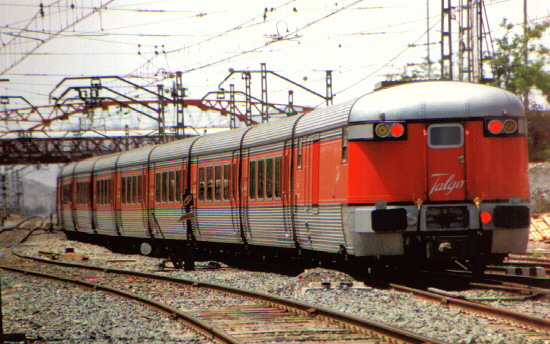 These trains were based on the Spanish TALGO principle were each car had
only two (separately hinged) wheels on one end and where the other end
was supported by the next car. Each set had two end cars of which one
had two sets of two wheels so that the complete set was self supporting.
In order to allow steering through curves the end wheels were in part
connected with the buffers and this required special measures on the
locomotive end to support this. Originally there were 5 RENFE diesel
locomotives (3001 T-3005 T, later 353 001-005) that hauled the sets the
complete route (two where based in Spain with wide gauge and three in
France and Switzerland with normal gauge, but bogeys could be exchanged).
Later these trains were hauled in France and Switzerland by French
locomotives (diesel at first, electric later) that were modified to allow
the special requirements, in Spain they were also replaced by standard
locomotives modified for the requirements. The sets have in this period
only been used in the Catalan Talgo,
and from 1974 also in the (non TEE train) Barcelona Talgo
(Barcelona-Paris).
These trains were based on the Spanish TALGO principle were each car had
only two (separately hinged) wheels on one end and where the other end
was supported by the next car. Each set had two end cars of which one
had two sets of two wheels so that the complete set was self supporting.
In order to allow steering through curves the end wheels were in part
connected with the buffers and this required special measures on the
locomotive end to support this. Originally there were 5 RENFE diesel
locomotives (3001 T-3005 T, later 353 001-005) that hauled the sets the
complete route (two where based in Spain with wide gauge and three in
France and Switzerland with normal gauge, but bogeys could be exchanged).
Later these trains were hauled in France and Switzerland by French
locomotives (diesel at first, electric later) that were modified to allow
the special requirements, in Spain they were also replaced by standard
locomotives modified for the requirements. The sets have in this period
only been used in the Catalan Talgo,
and from 1974 also in the (non TEE train) Barcelona Talgo
(Barcelona-Paris).
Photo: Manuel Pe�a, size: 94545 bytes.
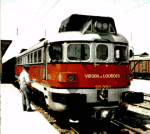 The 5 locomotives had names:
The 5 locomotives had names:
3001T: Virgen de Lourdes
3002T: Virgen de Fatima
3003T: Virgen del Yugo
3004T: Virgen de la Paloma
3005T: Virgen de la Bien Aparecida
Photo: Ernst Kers, size: 49734 bytes.
The following types of cars did exist:
- Open carriges (A3tu)
- seating 17 passengers, numbered RT 201-01 to 35. Later these were modified
in 13 1st class carriages (TA2 201.001-013, UIC 64 71 02-01 001 to 013)
and 22 2nd class carriages (TB2 202.001-022, UIC 64 71 02-02 001 to 022).
- Bar/kitchen car (Artu)
- numered RT 206-01 to 04. Later a fifth carriage was added and they
were renumbered into TC2 206.001-005, UIC 64 71 02-06 001 to 005.
- Restaurant car (Rux)
- coupled to the bar/kitchen car, seating 24, numbered RT 210-01 to 07,
later renumbered into TR2 210.001-007, UIC 64 71 02-10 001 to 007.
- Bagage/generator car (Dx)
- these were the end-cars coming in two versions; numbered RT 211-01 to 04
and RT 212-01 to 04. Later one of both was added and they were renumbered
into TG2z 211.001-005, UIC 64 71 02-11.001 to 005 (two wheelsets) and
TG2 212.001-005, UIC 64 71 02-12.001 to 005.
- First class sleeping car
- These were a later addition for the Barcelona Talgo, they had
10 places in compartments with 1 or 2 beds, numbering was
TWL3g 307.001-008, UIC 64 71 03-07 001 to 008.
- Second class sleeping car
- Also a later addition, 16 places in compartments with 4 beds, numbered
TWL3u 308.001-026, UIC 64 71 03-08 001 to 026.
Normally a train had two end cars, a bar/kitchen car, a restaurant car
at both sides of it and 9 open carriages. Four sets could be formed of
which one was short of an open carriage and a restaurant car. The later
Barcelona Talgo consisted mainly of sleeping carriages.
Locomotive hauled stock
Note: locomotives are mentioned later. Also much more stock has been
used, not especially built for TEE service and some of the later stock
was also used in other services.
SNCF carriages (Mistral)
This stock came in TEE service when the status of
le Mistral changed. Built in 1956.
The following cars did exist:
- Compartment carriage (A8myfi/A8u)
- Seating 48, numbered 5021-5042, from 1972 61 87 18-89 826-847.
- Bar car (A5smyfi/A5ru)
- The first were built 1954 under the numbers 5019-5020, 1956
renumbered 5081-5082 when also 5083 was built; from 1972
61 87 84-89 004, 005 and 007.
- Bagage/generator cars (Dsmyi/Dx)
- Rebuilt 1956 from older cars, numbered 5901-5905, later
61 87 81-89 451 to 455.
SNCF/NMBS-SNCB carriages (PBA)
 This stock was called PBA after the section for which it was intended:
Paris-Brussels-Amsterdam. Built 1964 partly for NMBS-SNCB partly for SNCF.
Here we see the open carriage in its later days.
This stock was called PBA after the section for which it was intended:
Paris-Brussels-Amsterdam. Built 1964 partly for NMBS-SNCB partly for SNCF.
Here we see the open carriage in its later days.
Photo: Stefan Nicolai, size: 138992 bytes.
 This photograph shows the trailing bagage/generator car.
This photograph shows the trailing bagage/generator car.
Photo: Stefan Nicolai, size: 76281 bytes.
It consisted of the following stock:
- Compartment carriage (A8myfi/A8u)

|
Seating 48 passengers, at first 31-37 later 61 87 18-89 881 to 887;
SNCF. |
- Open carriage (A8s/A8tu)

|
Seating 46, numbered 41-51 at first, from 1972 61 88 18-89 980 to 990;
NMBS-SNCB. |
- Open carriage + kitchen (A5smyfi/A5rtu)

|
Seating 29 passengers; meals were served from the kitchen on all seats
in the train. Numbered at first 21-27, from 1972 61 87 84-89 018 to 024; |
SNCF.
- Bar car (A3Rmyfi/A3rtu)

|
At first 15-18, later 61 87 84-89 025 to 028; SNCF. |
- Bagage/generator car (A2Dsmyi/A2Dx)

|
Numbered 1-7, later 1 and 2 were renumbered in 8 and 9; at the end of
1972 they got UIC numbers: 61 87 81-89 701 to 707; SNCF. |
SNCF/NMBS-SNCB/SBB-CFF-FFS carriages (Mistral 69)
Built first in 1968/70, later some were added in 1973/74. The following
cars were present ultimately:
- Compartment carriage (A8u)

|
Seating 48, numbered 61 87 18-89 888 to 914, later 943 to 957 were
added; SNCF. |
- Open carriages (A8tu)

|
46 places, numbered 61 87 18-89 915 to 942 (SNCF), later the following
were added: 61 88 18-89 991 to 996 (NMBS-SNCB) and 61 85 18-89 000 to 004
(SBB-CFF-FFS). |
- Restaurant car (Vru)

|
Numbered 61 87 88-89 051 to 061, later 062 and 063 were added; SNCF.
|
- Bar car plus open part (A3rtu)

|
Seating 17 plus bar, numbered 61 87 84-89 036 to 037 with 038 to 040
added later; SNCF. |
- Special bar car (Arux)

| Numbered 61 87 84-89 101 to 104, no later addition; SNCF.
|
- Bagage/generator car (A4Dtux)

| Numbered 61 87 81-89 711 to 724 with 725 to 729 added later; SNCF. |
SNCF carriages (Grand Confort)
Built 1969/70, the following were present:
- Compartment carriage (A8u)

| 48 places, numbered 61 87 18-99 001 to 012 and 026 to 053. |
- Open carriage (A8tu)

| Seating 46, numbered 61 87 18-99 013 to 025 and 054 to 061, in 1973/74
062 to 074 were added. |
- Restaurant car (Vru)

| 61 87 88-99 001 to 010. |
- Bar car plus open part (A3rtu)

|
Seating 17, 61 87 84-99 001 to 006. |
- Bagage/generator car (A4Dtux)

|
61 87 81-99 001 to 013. |
DB carriages
Originally built for the Rheingold
before it got TEE status in 1962/63 and a later delivery in 1964/65.
The following cars existed:
- Compartment carriages (Av4üm-62/Avümh 111)

|
54 places, numbered 10401-10436 at first, renumbered in 1967 in
61 80 19-80 001 to 022 (first delivery) and 101 to 114 (second delivery).
In 1976 the letter ü was removed from the designation.
Paint schemes and their time periods |
- Open carriages (Ap4üm-62/Apümh 121)

|
Seating 48, the first part of the first delivery was numbered 10421-10425
at first, in 1963 renumbered in 10501-10505, the remainder got numbers
10506-10525;
in 1967 renumbered in 61 80 18-80 001 to 011 and 101 to 113 for first and
second delivery (10513 was lost in 1965).
In 1976 the letter ü was removed from the designation.
Paint schemes and their time periods
|
- Panorama car with bar and bagage compartment (AD4üm-62/ADümh 101)

|
In addition two compartments for (total) 12 passengers; numbered 10551-10555
at first, renumbered in 61 80 81-80 001 to 005.
In 1976 the letter ü was removed from the designation.
Paint schemes and their time periods
|
- Restaurant car (WR4üm-62/WRümh 131)

|
At first delivered to DSG (Deutsche Schlafwagen Gesellschaft) and DB
under numbers 101-102 (DSG) and 11103-11105, in 1966 the DSG cars came to
DB under numberes 11101-11102. From 1967 61 80 88-80 001 to 005.
In 1976 the letter ü was removed from the designation.
Paint schemes and their time periods
|
Until 1969 the following were added:
- Avmh 111
-
- Apmh 121
-
- ARDmh 105
-
- WRmh 132
-
From 1972 many more carriages were added but there was no longer a strict
separation between cars used for TEE trains and cars used for other fast
trains.
FS carriages
FS used a strict separation between the carriages used for international
trains and those for national trains. The following types were available
(built about 1969):
- Compartment carriage (A)
-
- Open carriage (As/Ap)
-
- Restaurant car (WR)
-
- Bagage car (Ds)

|
numbered 61 83 95-900 to 904 (international only) the last two
were originally numbered 951 and 952. In 1972 followed bagage cars
for national trains: 50 83 95-98 000 to 019.
Paint schemes and their time periods
|
SBB-CFF-FFS carriage
Only one carriage in this group.
- Restaurant car (UIC WRm RIC)
-
Locomotives
In many cases the locomotive hauled trains were hauled by standard
locomotives from various series; however some series were initially
specially intended for TEE trains and from other series some locomotives
got a special TEE colour; those are mentioned below.
SNCF locomotives
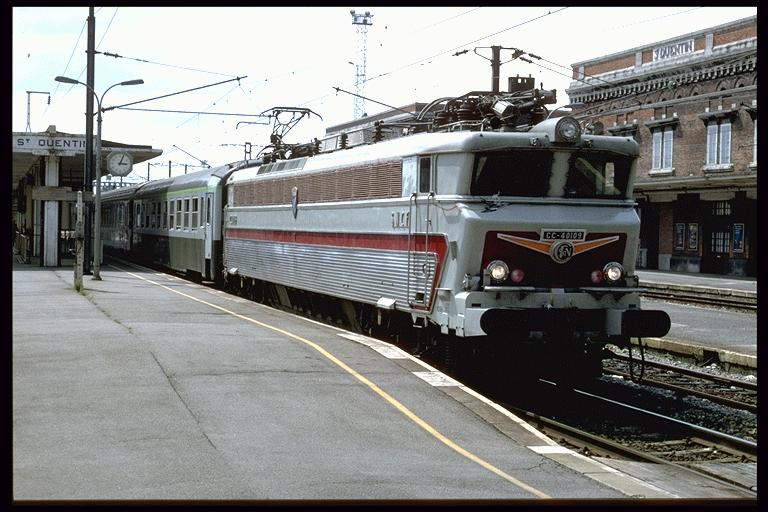 There was only one series that was intended especially for TEE trains
(although it did not get the TEE colour): CC 40101-40110. These were
locomotives that were intended to haul the trains from Paris through
to the Netherlands and Germany and back, however they never actually
saw service in the Netherlands and Germany and they were used mostly
for TEE trains and other fast trains to Belgium. The first 4 locomotives
were built in 1964, the last 6 in 1970. After an accident CC 40106 was
completely rebuilt in 1973.
There was only one series that was intended especially for TEE trains
(although it did not get the TEE colour): CC 40101-40110. These were
locomotives that were intended to haul the trains from Paris through
to the Netherlands and Germany and back, however they never actually
saw service in the Netherlands and Germany and they were used mostly
for TEE trains and other fast trains to Belgium. The first 4 locomotives
were built in 1964, the last 6 in 1970. After an accident CC 40106 was
completely rebuilt in 1973.
Photo: Jean-Paul Lescat, size: 76898 bytes.
NMBS-SNCB locomotives
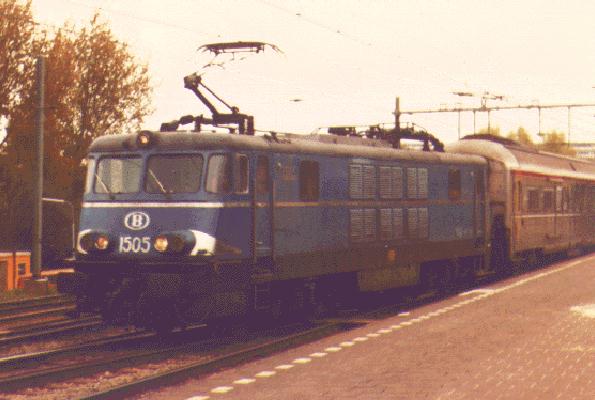 Three series were built for (and mostly used for) TEE service, the
first one was: 1501-1505 (formerly 150.001-150.003, 150.011 and 150.012) in
1962. These could be used in France, Belgium and the Netherlands.
Three series were built for (and mostly used for) TEE service, the
first one was: 1501-1505 (formerly 150.001-150.003, 150.011 and 150.012) in
1962. These could be used in France, Belgium and the Netherlands.
Photo: Ben Doedens, size: 36182 bytes.
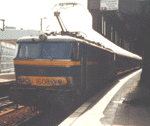 The second series was the 1601-1608
(formerly 160.001-160.004 and 160.021-160.024) in 1966, usable in the
same countries plus Germany.
The second series was the 1601-1608
(formerly 160.001-160.004 and 160.021-160.024) in 1966, usable in the
same countries plus Germany.
Photo: Tobias Koehler, size: 74460 bytes.
 The third series was 1801-1806 in 1973. This series could also be used in
the same four countries as series 1600. The 1800 series is identical to
the French CC 40100 series.
The third series was 1801-1806 in 1973. This series could also be used in
the same four countries as series 1600. The 1800 series is identical to
the French CC 40100 series.
Photo: Tobias Koehler, size: 22840 bytes.
DB locomotives
 The history of the electric locomotives for TEE trains is tightly coupled
with the later TEE Rheingold/Rheinpfeil. Originally also a 1st class
only fast train, however, not TEE and painted in blue and beige rather
then the TEE red and beige. The first locomotives painted in their
colours came from the E10 series. First in 1962 E10 239-244 that got
renumbered in E10 1239-1244 when they were modified to allow higher speed, when
(also in 1962) the high speed standard series came they were remodified and
numbered back. The high speed series started with E10 1265-1270 (later
112 265-270); they had a modified cab design. In 1963 a second batch was
modified and repainted (E10 250-254) for Rheinpfeil, but not renumbered.
In 1964 they were modified back in standard form when the second batch of
the high speed version came, E10 1308-1312 (later 112 308-312). Finally
in 1968 came a third batch, 112 485-504. They were all ultimately painted
in TEE colours.
The history of the electric locomotives for TEE trains is tightly coupled
with the later TEE Rheingold/Rheinpfeil. Originally also a 1st class
only fast train, however, not TEE and painted in blue and beige rather
then the TEE red and beige. The first locomotives painted in their
colours came from the E10 series. First in 1962 E10 239-244 that got
renumbered in E10 1239-1244 when they were modified to allow higher speed, when
(also in 1962) the high speed standard series came they were remodified and
numbered back. The high speed series started with E10 1265-1270 (later
112 265-270); they had a modified cab design. In 1963 a second batch was
modified and repainted (E10 250-254) for Rheinpfeil, but not renumbered.
In 1964 they were modified back in standard form when the second batch of
the high speed version came, E10 1308-1312 (later 112 308-312). Finally
in 1968 came a third batch, 112 485-504. They were all ultimately painted
in TEE colours.
Photo: MicroVision Photo-CD Picture-Show 21, copyright TRONIC-Verlag,
size: 50705 bytes.
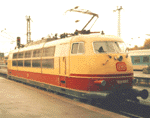 The second series that had TEE colours (already from the start) was the
E03/103 series. First came in 1965 the prototype series E03 001-004
(later 103 001-004) and from 1970 the standard series 103 101-245.
Initially used for TEE service, later (when in Germany the distinction
between TEE and other national services became blurred) also for other
services.
The second series that had TEE colours (already from the start) was the
E03/103 series. First came in 1965 the prototype series E03 001-004
(later 103 001-004) and from 1970 the standard series 103 101-245.
Initially used for TEE service, later (when in Germany the distinction
between TEE and other national services became blurred) also for other
services.
Photo: Tobias Koehler, size: 73272 bytes.
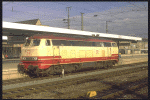 A few diesellocomotives have also been painted in TEE colors, for service on the
Merkur from Hamburg to the ferry, and on the
Bavaria: 218 217 (which we see here) and
218 from the series 218 001-499) and 221 115 (from the series 221 101-150,
formerly V200 101-150).
A few diesellocomotives have also been painted in TEE colors, for service on the
Merkur from Hamburg to the ferry, and on the
Bavaria: 218 217 (which we see here) and
218 from the series 218 001-499) and 221 115 (from the series 221 101-150,
formerly V200 101-150).
Photo: Christian Splittgerber, size: 112762 bytes.
SBB-CFF-FFS locomotives
 In Switzerland a few locomotives have been painted in TEE colours for TEE
service. First 10033, 10034, 10046 and 10050 of series Re 4/4 I
10027-10050. The photo shows an Re 4/4 I in original colours but with
TEE shield.
In Switzerland a few locomotives have been painted in TEE colours for TEE
service. First 10033, 10034, 10046 and 10050 of series Re 4/4 I
10027-10050. The photo shows an Re 4/4 I in original colours but with
TEE shield.
Photo: copyright by photo archives service of the Swiss Federal Railways,
3030 Bern, Switzerland, size: 30244 bytes.
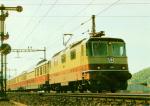 From the Re 4/4 II series 11156-11304 also a number got TEE livery:
11158-11161 and 11249-11253. The second batch was delivered as TEE.
From the Re 4/4 II series 11156-11304 also a number got TEE livery:
11158-11161 and 11249-11253. The second batch was delivered as TEE.
Photo: W. Hanisch, size: 68680 bytes.
FS locomotives
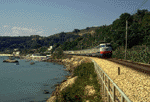 The Italian TEE services were mostly hauled by locomotives from the series
E 444.001-117, but none has been painted specially.
The Italian TEE services were mostly hauled by locomotives from the series
E 444.001-117, but none has been painted specially.
Photo: S. Paolini, size: 72482 bytes.
DSB locomotives
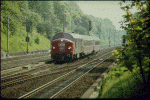 For the short time the
Merkur did exist they were hauled in
Danmark by the standard MX-1 locomotives. We see here such a locomotive
actually hauling the TEE train (consisting of only two carriages).
For the short time the
Merkur did exist they were hauled in
Danmark by the standard MX-1 locomotives. We see here such a locomotive
actually hauling the TEE train (consisting of only two carriages).
Photo: Jan Agersten, size: 247547 bytes.
Additional sources:
See also my complete transport catalog.
[Baz84] Bäzold & Fiebig
Elektrische Lokomotiven deutscher Eisenbahnen
ISBN 3 87094 093 X
Alba Buchverlag, Düsseldorf, Germany, 1984
[Cal78] Luc Calay, Gerrit Nieuwenhuis & Yves Steenebruggen
Benelux Lokomotieven en Treinstellen 1977-01-01
ISBN 91 7266 029 5
Frank Stenvalls Förlag, Malmö, Sweden, 1978
[Che79] Fabio Cherubini
Materiale Motore F.S. Italia, 1979-01-01
ISBN 91 7266 043 0
Frank Stenvalls Förlag, Malmö, Sweden, 1979
[Gla81] Glatte
Diesellokomotiven deutscher Eisenbahnen
ISBN 3 87094 077 8
Alba Buchverlag, Düsseldorf, Germany, 1981
[Obe70] Horst J. Obermayer
Taschenbuch Deutsche Elektrolokomotiven
ISBN 3 440 03754 1
Franckh'sche Verlagshandlung, Stuttgart, Germany, 1970
[Obe72] Horst J. Obermayer
Taschenbuch Deutsche Diesellokomotiven
ISBN 3 440 03932 3
Franckh'sche Verlagshandlung, Stuttgart, Germany, 1972
[Obe73] Horst J. Obermayer
Taschenbuch Deutsche Triebwagen
ISBN 3 440 04054 2
Franckh'sche Verlagshandlung, Stuttgart, Germany, 1973
[Obe78] Horst J. Obermayer
Taschenbuch Deutsche Reisezugwagen
ISBN 3 440 04589 7
Franckh'sche Verlagshandlung, Stuttgart, Germany, 1978
[Wil76] Peter Wilen
Lokomotiven und Triebwagen der Schweizer Bahnen
Band 1: Schweizerische Bundesbahnen (SBB)
ISBN 3 280 00813 1
Orell Füssli Verlag, Zürich, Switzerland, 1976
[Zsc77] Zschech
Triebwagen deutscher Eisenbahnen
Band 1: ET und ETA
ISBN 3 87094 052 2
Alba Buchverlag, Düsseldorf, Germany, 1977
[Zsc77a] Zschech
Triebwagen deutscher Eisenbahnen
Band 2: VT und DT
ISBN 3 87094 062 X
Alba Buchverlag, Düsseldorf, Germany, 1977





 These were based on the already proven RGP 825 trainsets (which is shown by
the photo). They consisted
of a motorcar (X 2771-2781) and a driving trailer (XRS 7771-7779).
The motorcar seated 39 passengers, the trailer had 42 seats,
a kitchen and a service compartment. Built 1956/57. Intermediate
cars have been built, but I do not have information about them. These
sets could be coupled with the original RPG 825 sets, and this was done
on some French parts of TEE routes.
These were based on the already proven RGP 825 trainsets (which is shown by
the photo). They consisted
of a motorcar (X 2771-2781) and a driving trailer (XRS 7771-7779).
The motorcar seated 39 passengers, the trailer had 42 seats,
a kitchen and a service compartment. Built 1956/57. Intermediate
cars have been built, but I do not have information about them. These
sets could be coupled with the original RPG 825 sets, and this was done
on some French parts of TEE routes.
 The principle was based on the trainsets already running in the Netherlands.
A set consisted of a motorcar (with compartments for bagage, service and
customs), a compartment car for 54 passengers, a restaurant car seating
32 passengers with compartments for 18 passengers and a driving trailer
seating 42 passengers. Built 1956/57. Numbers:
NS 1001-1003 and SBB-CFF-FFS RAm 501-502.
The principle was based on the trainsets already running in the Netherlands.
A set consisted of a motorcar (with compartments for bagage, service and
customs), a compartment car for 54 passengers, a restaurant car seating
32 passengers with compartments for 18 passengers and a driving trailer
seating 42 passengers. Built 1956/57. Numbers:
NS 1001-1003 and SBB-CFF-FFS RAm 501-502.
 Because the intended trainsets were not ready in time as a temporary measure
some sets of this series have done service in TEE trains.
Because the intended trainsets were not ready in time as a temporary measure
some sets of this series have done service in TEE trains.
 Built 1957. Since 1968 numbered in the 601 series. The trainsets were
expandable and could easily be split and joined.
Built 1957. Since 1968 numbered in the 601 series. The trainsets were
expandable and could easily be split and joined.
 Built also 1957 (and two in 1958), but due to late delivery the intended
trains could not start immediately with the beginning of the summer timetable
of 1957. The sets consisted of a motorcar (ALn 442.201-209) seating 42 and
a driving trailer (ALn 448.201-209) seating 48 with a kitchen and customs
compartment. In 1969 ALn 442.202 was replaced by ALn 442.209 and
in 1971 ALn 448.207 by ALn 448.209; both after accidents. Intermediate cars
have been built but were never actually used in the TEE sets.
Built also 1957 (and two in 1958), but due to late delivery the intended
trains could not start immediately with the beginning of the summer timetable
of 1957. The sets consisted of a motorcar (ALn 442.201-209) seating 42 and
a driving trailer (ALn 448.201-209) seating 48 with a kitchen and customs
compartment. In 1969 ALn 442.202 was replaced by ALn 442.209 and
in 1971 ALn 448.207 by ALn 448.209; both after accidents. Intermediate cars
have been built but were never actually used in the TEE sets.
 Built in 1961 as RAe II 1051-1054, in 1962 1055 was added. The sets were able
to drive on four different current systems: 1500 and 3000 V DC, 15000 V
16 2/3 Hz AC and 25000 V 50 Hz AC. The motorcar had four pantographs, one
for Switzerland, one for Germany and Austria (originally in this position
there was one for the DC part of France), one for Italy and the AC part
of France and one for the DC part (France, Belgium and the Netherlands,
originally not for France). (Although Switzerland used the same system as
Germany and Austria, requirements for pantographs are very different, hence
the two pantographs for these parts). The driver had in front of him a
push button panel with a button for each region; a single push would
activate the appropriate pantograph and set for the correct current.
The sets consisted of a
driving trailer seating 42, the motor car, a restaurant car with 48 places
plus 6 places at the bar, an intermediate open car with 42 places and
another driving trailer with 42 seats. Later a sixth open car with 42 places
was added at the position where the driving trailer joined the motorcar.
Built in 1961 as RAe II 1051-1054, in 1962 1055 was added. The sets were able
to drive on four different current systems: 1500 and 3000 V DC, 15000 V
16 2/3 Hz AC and 25000 V 50 Hz AC. The motorcar had four pantographs, one
for Switzerland, one for Germany and Austria (originally in this position
there was one for the DC part of France), one for Italy and the AC part
of France and one for the DC part (France, Belgium and the Netherlands,
originally not for France). (Although Switzerland used the same system as
Germany and Austria, requirements for pantographs are very different, hence
the two pantographs for these parts). The driver had in front of him a
push button panel with a button for each region; a single push would
activate the appropriate pantograph and set for the correct current.
The sets consisted of a
driving trailer seating 42, the motor car, a restaurant car with 48 places
plus 6 places at the bar, an intermediate open car with 42 places and
another driving trailer with 42 seats. Later a sixth open car with 42 places
was added at the position where the driving trailer joined the motorcar.
 These were not especially built for the TEE but actually very old.
This series (ETR 301-303, the first two built 1953 and the third in 1959)
was already used in the luxuary
Settebello and came into TEE service
without change when the service was classified TEE. When the sets would
be retracted from TEE service in 1984 the train was renamed to
Colosseum
because the old name was connected with the trainsets rather than the service.
Actually these sets consist of three parts; both ends are formed from two cars
with a jointly used middle bogey; the middle part is three cars with two
jointly used middle bogeys.
These were not especially built for the TEE but actually very old.
This series (ETR 301-303, the first two built 1953 and the third in 1959)
was already used in the luxuary
Settebello and came into TEE service
without change when the service was classified TEE. When the sets would
be retracted from TEE service in 1984 the train was renamed to
Colosseum
because the old name was connected with the trainsets rather than the service.
Actually these sets consist of three parts; both ends are formed from two cars
with a jointly used middle bogey; the middle part is three cars with two
jointly used middle bogeys.
 Only one kind was used by DB and that only for the
Lufthansa Airport Express. This was
the series 403/404 luxuary trainsets.
Only one kind was used by DB and that only for the
Lufthansa Airport Express. This was
the series 403/404 luxuary trainsets.
 These trains were based on the Spanish TALGO principle were each car had
only two (separately hinged) wheels on one end and where the other end
was supported by the next car. Each set had two end cars of which one
had two sets of two wheels so that the complete set was self supporting.
In order to allow steering through curves the end wheels were in part
connected with the buffers and this required special measures on the
locomotive end to support this. Originally there were 5 RENFE diesel
locomotives (3001 T-3005 T, later 353 001-005) that hauled the sets the
complete route (two where based in Spain with wide gauge and three in
France and Switzerland with normal gauge, but bogeys could be exchanged).
Later these trains were hauled in France and Switzerland by French
locomotives (diesel at first, electric later) that were modified to allow
the special requirements, in Spain they were also replaced by standard
locomotives modified for the requirements. The sets have in this period
only been used in the Catalan Talgo,
and from 1974 also in the (non TEE train) Barcelona Talgo
(Barcelona-Paris).
These trains were based on the Spanish TALGO principle were each car had
only two (separately hinged) wheels on one end and where the other end
was supported by the next car. Each set had two end cars of which one
had two sets of two wheels so that the complete set was self supporting.
In order to allow steering through curves the end wheels were in part
connected with the buffers and this required special measures on the
locomotive end to support this. Originally there were 5 RENFE diesel
locomotives (3001 T-3005 T, later 353 001-005) that hauled the sets the
complete route (two where based in Spain with wide gauge and three in
France and Switzerland with normal gauge, but bogeys could be exchanged).
Later these trains were hauled in France and Switzerland by French
locomotives (diesel at first, electric later) that were modified to allow
the special requirements, in Spain they were also replaced by standard
locomotives modified for the requirements. The sets have in this period
only been used in the Catalan Talgo,
and from 1974 also in the (non TEE train) Barcelona Talgo
(Barcelona-Paris).
 The 5 locomotives had names:
The 5 locomotives had names: This stock was called PBA after the section for which it was intended:
Paris-Brussels-Amsterdam. Built 1964 partly for NMBS-SNCB partly for SNCF.
Here we see the open carriage in its later days.
This stock was called PBA after the section for which it was intended:
Paris-Brussels-Amsterdam. Built 1964 partly for NMBS-SNCB partly for SNCF.
Here we see the open carriage in its later days.
 This photograph shows the trailing bagage/generator car.
This photograph shows the trailing bagage/generator car.























 There was only one series that was intended especially for TEE trains
(although it did not get the TEE colour): CC 40101-40110. These were
locomotives that were intended to haul the trains from Paris through
to the Netherlands and Germany and back, however they never actually
saw service in the Netherlands and Germany and they were used mostly
for TEE trains and other fast trains to Belgium. The first 4 locomotives
were built in 1964, the last 6 in 1970. After an accident CC 40106 was
completely rebuilt in 1973.
There was only one series that was intended especially for TEE trains
(although it did not get the TEE colour): CC 40101-40110. These were
locomotives that were intended to haul the trains from Paris through
to the Netherlands and Germany and back, however they never actually
saw service in the Netherlands and Germany and they were used mostly
for TEE trains and other fast trains to Belgium. The first 4 locomotives
were built in 1964, the last 6 in 1970. After an accident CC 40106 was
completely rebuilt in 1973.
 Three series were built for (and mostly used for) TEE service, the
first one was: 1501-1505 (formerly 150.001-150.003, 150.011 and 150.012) in
1962. These could be used in France, Belgium and the Netherlands.
Three series were built for (and mostly used for) TEE service, the
first one was: 1501-1505 (formerly 150.001-150.003, 150.011 and 150.012) in
1962. These could be used in France, Belgium and the Netherlands.
 The second series was the 1601-1608
(formerly 160.001-160.004 and 160.021-160.024) in 1966, usable in the
same countries plus Germany.
The second series was the 1601-1608
(formerly 160.001-160.004 and 160.021-160.024) in 1966, usable in the
same countries plus Germany.
 The third series was 1801-1806 in 1973. This series could also be used in
the same four countries as series 1600. The 1800 series is identical to
the French CC 40100 series.
The third series was 1801-1806 in 1973. This series could also be used in
the same four countries as series 1600. The 1800 series is identical to
the French CC 40100 series.
 The history of the electric locomotives for TEE trains is tightly coupled
with the later TEE Rheingold/Rheinpfeil. Originally also a 1st class
only fast train, however, not TEE and painted in blue and beige rather
then the TEE red and beige. The first locomotives painted in their
colours came from the E10 series. First in 1962 E10 239-244 that got
renumbered in E10 1239-1244 when they were modified to allow higher speed, when
(also in 1962) the high speed standard series came they were remodified and
numbered back. The high speed series started with E10 1265-1270 (later
112 265-270); they had a modified cab design. In 1963 a second batch was
modified and repainted (E10 250-254) for Rheinpfeil, but not renumbered.
In 1964 they were modified back in standard form when the second batch of
the high speed version came, E10 1308-1312 (later 112 308-312). Finally
in 1968 came a third batch, 112 485-504. They were all ultimately painted
in TEE colours.
The history of the electric locomotives for TEE trains is tightly coupled
with the later TEE Rheingold/Rheinpfeil. Originally also a 1st class
only fast train, however, not TEE and painted in blue and beige rather
then the TEE red and beige. The first locomotives painted in their
colours came from the E10 series. First in 1962 E10 239-244 that got
renumbered in E10 1239-1244 when they were modified to allow higher speed, when
(also in 1962) the high speed standard series came they were remodified and
numbered back. The high speed series started with E10 1265-1270 (later
112 265-270); they had a modified cab design. In 1963 a second batch was
modified and repainted (E10 250-254) for Rheinpfeil, but not renumbered.
In 1964 they were modified back in standard form when the second batch of
the high speed version came, E10 1308-1312 (later 112 308-312). Finally
in 1968 came a third batch, 112 485-504. They were all ultimately painted
in TEE colours.


 In Switzerland a few locomotives have been painted in TEE colours for TEE
service. First 10033, 10034, 10046 and 10050 of series Re 4/4 I
10027-10050. The photo shows an Re 4/4 I in original colours but with
TEE shield.
In Switzerland a few locomotives have been painted in TEE colours for TEE
service. First 10033, 10034, 10046 and 10050 of series Re 4/4 I
10027-10050. The photo shows an Re 4/4 I in original colours but with
TEE shield.

 The Italian TEE services were mostly hauled by locomotives from the series
E 444.001-117, but none has been painted specially.
The Italian TEE services were mostly hauled by locomotives from the series
E 444.001-117, but none has been painted specially.
 For the short time the
Merkur did exist they were hauled in
Danmark by the standard MX-1 locomotives. We see here such a locomotive
actually hauling the TEE train (consisting of only two carriages).
For the short time the
Merkur did exist they were hauled in
Danmark by the standard MX-1 locomotives. We see here such a locomotive
actually hauling the TEE train (consisting of only two carriages).